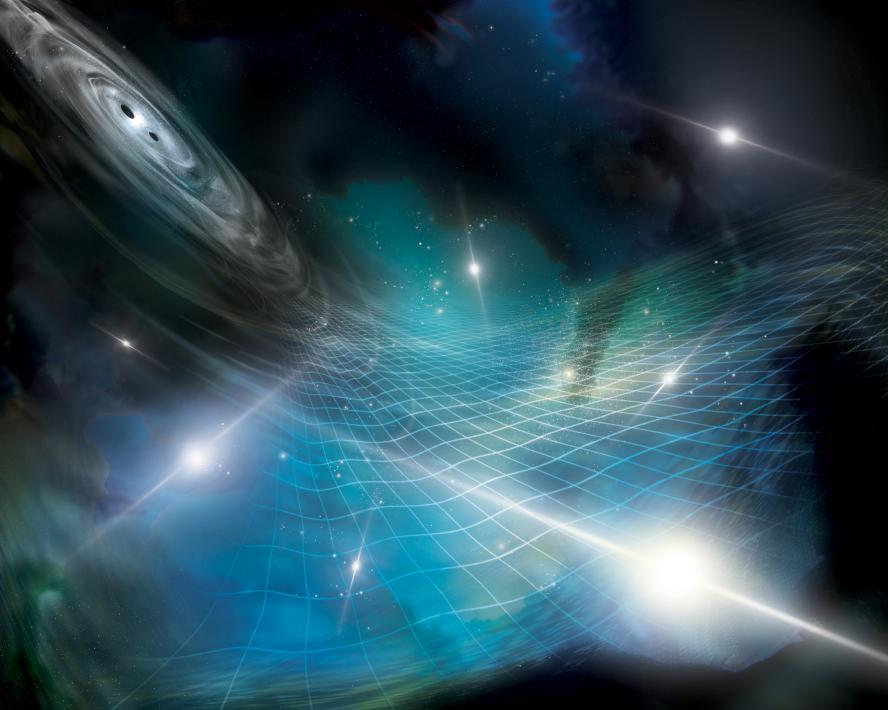Tufts’ Ken Olum Searches for Evidence of Cosmic Strings in a Background of Gravitational Waves

This week, the NSF-funded North American Nanohertz Observatory for Gravitational Waves (NANOGrav) announced results from its 15-year search for a background of gravitational waves, finding potential evidence of supermassive black hole binary systems, and possibly other exotic astrophysical phenomena such as cosmic strings, or phase transitions that occurred after the first moments of the Big Bang. Ken Olum, professor of physics and astronomy, was one of a team of scientists who collected, analyzed and modeled the data.
“It's a remarkable, and ongoing effort, in which the team identified 68 pulsars throughout our galaxy to act as a galaxy-sized gravitational wave detector,” said Olum. Pulsars are stars that have gone supernova, and collapsed into extremely dense, rapidly spinning neutron stars that blast out pulses of radiation like lighthouses at intervals of seconds to milliseconds. Their timing is so precise that they can serve as cosmological clocks. As gravitational waves pass through our galaxy, space and time are stretched and squeezed, causing the pulses to arrive earlier or later than expected.
“We observed each pulsar about once a month, measuring many thousands of peaks only milliseconds apart,” explained Olum. “If a gravitational wave passes through it, the train of pulses will be a little bit early or a little bit late. We were looking for changes as small as a microsecond over periods of a few months to years.”
Prof Olum was part of a team that took on the critical task of optimizing the speed at which the massive amount of data could be analyzed. Thousands of hours of radio telescope observations and billions of millisecond pulses had to be processed.
The pattern of pulsar timing showed strong evidence for a background of gravitational waves flowing through the galaxy with peaks separated by years to decades. The current hypothesis is that the hum of gravitational waves is caused at least in part by supermassive black hole pairs – millions or billions of times more massive than the sun – that orbit each other at the heart of distant galaxies throughout the universe. As these behemoths spiral around each other, they create low frequency gravitational waves in the fabric of spacetime like ripples in a pond.
Olum adds that other sources could contribute to the symphony of gravitational noise, and they could provide hints to events that happened at the earliest stages of the universe, back to the first fraction of a second of time.
One possible source is cosmic strings, a focus of Olum’s own research. “According to cosmological theory, the strings could come from the very beginnings of the universe, during a time when all the fundamental forces in nature – electromagnetic, weak, and strong nuclear forces – were unified. The phase transition when this ‘grand unification’ broke down could lead to the formation of massive strings, thinner than a proton but light years long, sort of like when cracks form on the icy surface of a pond when it begins to melt. Cosmic strings could also be the fundamental strings of string theory stretched long by the expansion of the universe.”
Olum conducted modeling studies to see if the existence of cosmic strings could explain the spectrum of gravitational waves observed from the NANOGrav project. “We modeled black holes alone versus black holes plus cosmic strings, and it appears more likely to include certain kinds of strings,” said Olum. “But at this point there are too many unknowns even about how black holes behave at the centers of galaxies, so firm conclusions about the existence of cosmic strings or other exotic possibilities will have to wait for future studies.”
NANOGrav works together with other pulsar timing array collaborations around the world, which released their results at the same time. “An important step in coming years will be to combine the data from all the collaborations. The power of this combined dataset may give us new, exciting insights into the gravitational wave universe.”
Department:
Physics and Astronomy